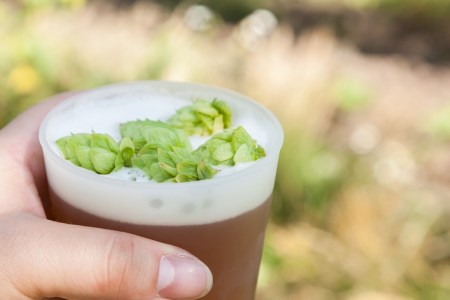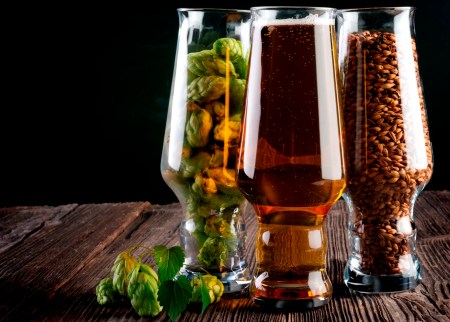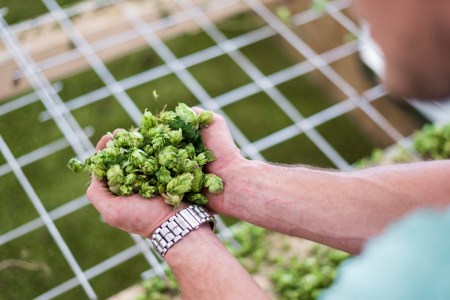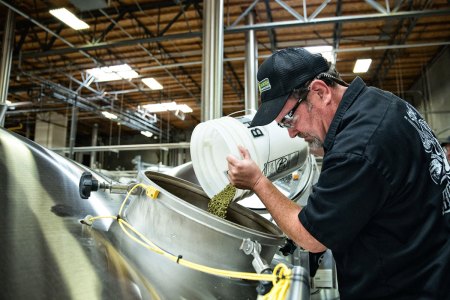
In each issue of Beer & Brewer magazine Brightstar‘s brewer Steve Brockman delves into a subject pertinent to the season to help you brew better beer. His Deep Dive series of articles kicked off in the Summer 2021/22 edition where he talked us through making great fruit beers to match the warmer weather. His latest article in our recently released Autumn edition, which comes after what appears to have been a solid harvest this year, is on harnessing hops in your beers and we’ve reproduced that article here. Steve’s next article in the Winter issue will be on stouts, where he’ll cover the full gamut, from philosophies on how to maximise mouthfeel while keeping it drinkable to serving temperatures for Instagram-worthy pours. To read that and future ones, as well as articles just like it from other industry experts, subscribe to Beer & Brewer magazine.
It could be argued that no single ingredient has shaped the history of craft beer more than hops. From humble beginnings in modestly hopped English ales, to the defining hop bombs of West Coast IPA to the current fruit-forward NEIPAs and hazy pales, hops have been, and will continue to be, the trend-setting ingredient in beer.
But how do you maximise hops in your next beer?
Lay a good base
While hops certainly are the star of a great IPA or hoppy pale ale, the key to making great hoppy beers comes with careful planning of all the other ingredients.
When deciding on your recipe, think of the style you’re trying to brew. Is it a crystal-clear, dank West Coast IPA? Is it a big, bold Double IPA? Is it a juicy, soft pillowy NEIPA? Or is it a cruisy, approachable pale?
Once you’ve decided on the sub-style you’re aiming for, simplicity is key.
Malt bills for West Coast style IPAs should be fairly simple – a clean base malt can make up all of your grist. Back in the 90s and early 2000s brewers often used to put crystal malt into their West Coast IPAs but brewers have now turned away from including it, as the cloying sweetness detracts from the punchy crispness of a great IPA.

Yeast should be clean too – a simple US05 or California Ale strain ferments clean, allowing the hops to shine.
Double and Imperial IPAs can carry more weight of flavour. Bigger beers generally come with higher alcohol content, and this alcohol can affect flavour. Aim for a higher finishing gravity to balance the extra hop load. Crystal malts can be used carefully to provide a bigger malt backbone to layer the hops on. High alcohol can also be stressful for your yeast and result in unpleasant nail polish/solvent character. Avoid it by pitching an appropriate amount of yeast and keep an eye on the ferment temperature.
On the other side of the spectrum, hoppy pale ales and session beers don’t have the alcohol to carry a super large hop load. Think simple malt bills for these beers, with a little Vienna malt to add a depth of flavour. Try fermenting with English Ale strains here as leaving a little body post ferment allows you to add a good amount of hops without overwhelming the beer, making it astringent.
A general rule of thumb for NEIPA recipes include using oats and ale malts for a fuller, sweeter mouthfeel. This fuller mouthfeel supports larger amounts of fruity hops being added later in the process. Yeast derived esters can also go a long way in helping hops shine in the final product.
Water can also be the difference between a good and outstanding NEIPA. Softer, low minerality water is a great start, filtered to remove chlorine/chloramines. RO (Reverse Osmosis) water is even better to start with, but can be expensive to set up.
Generally brewers aim for a high chloride to sulphate (2:1 up to 3:1) ratio when brewing a hazy. To adjust your water, obtain a water report for your brewing water, either through your local council or water authority or through a paid lab service. Use a program such as Bru’n Water or Beer Smith to input your water report, and aim for a total 200 ppm chloride, 100ppm sulphate.
You can use calcium chloride and calcium sulphate (gypsum) to make these additions to your brewing water, making sure you end up with roughly 100ppm calcium for yeast health.

The right hop for the job
Traditionally, hops are broadly split into two families when it comes time to write a hop schedule – bittering and aroma. But more modern brewers now think of hops across four categories – bittering, flavour, aroma and dry hop.
The best West Coast IPAs and hoppy pales use clean and targeted bittering hops such as Magnum, Nugget and Super Pride. These are tried and true hops to provide alpha acids in an efficient way without much flavour addition. Adding with 60 minutes to go in the boil ensures all alpha acids are isomerised.
When deciding on how much hops to add to a bittering charge, err on the lighter side of the scale. A good rule of thumb used to be approximately 10 IBUs per percentage of alcohol (ie. 60 IBU for a 6.0% beer), but many modern IPAs now might be bittered to as low as half that ratio. Brewers can also use CO2 extract to cut down on the amount of hop matter in the kettle, thus reducing potential for vegetal off flavours. Less hop matter also helps increase brewing yields as well.
Heavily hopped beers are notoriously inefficient beers, with final volume losses of up to 20 per cent, with big hop loads soaking up the beer. While hop chemistry is extremely complex and consists of many different compounds, flavour and aroma hops are generally hops that are high in essential oils. Within these essential oils are highly volatile hydro-carbons, such as myrcene (green, herbaceous “hoppiness”), humulene (woody/spicy) and caryophyllene (sweet spice). In a vigorous rolling boil these compounds are blown off and lost, so flavour additions generally are put in somewhere between 10 to 20 minutes before flameout.
Also within those essential oils are oxygen containing compounds called monoterpenes which is a type of terpenoid. Hops high in monoterpenes such as linalool (citrus), geraniol (floral like geraniums) and betacitronellol (lemongrass/fresh grass) are great additions as late hops. The technique of hop bursting – adding most of your hops late in the boil, with less than 15 minutes to go – is a great way of driving fruity, citrus character into your beer. Choose hops with high oil content and terpenoids such as Centennial, Citra, Mosaic and Simcoe.
Some brewers of particularly hop forward beers also favour large additions at flameout and whirlpool. With such large additions, overall bitterness can be affected, as alpha acids will continue to convert into iso-alpha acids in the hot wort. You can eliminate some of the bitterness by dropping the temperature of the wort at the end of boil to roughly 80°C before adding your whirlpool addition.
Professional brewers can easily achieve this by circulating through their heat exchanger, but home brewers can emulate this by running a cooling coil with ice water.
There are a swathe of different hop products on the market to help brewers maximise the flavours and aromas in their hoppy beers and it’s worth taking the time to work out where each product is best utilised.
T45 hop pellets and lupulin maximised products increase the amount of lupulin (the sticky yellow goodness inside the hop that contains the aromatic oils) in pellets and powder. The result is a more intense aroma impact for less physical material, allowing brewers to maximise yields, and avoid extracting undesirable off-flavours. It excels at both late hopping (flameout and whirlpool) and in dry hop.

Fine tune the dry hop
Ask any brewer about the way they dry hop, and you’ll get a different answer every time.
There are, however, some golden rules to follow. If you are chasing a particularly fruity, juicy hop aroma for a NEIPA, adding hops before the end of fermentation is a good idea. In this “biotransformation”, select yeast strains work on converting terpenoids into other flavour active terpenoids. While it sounds complicated, it is quite simple: when your fermentation has passed high kräusen (the most intense fermentation stage) add your high oil content hops. This process can change onion/garlic hop aromas into intense citrus and tropical notes in your beer.
Even if you choose not to “biotransform”, many brewers follow the three Ts of dry hopping – time, turbulence and temperature.
Recent hop studies have suggested that short, sharp stints on dry hops maximise extraction of desirable hop compounds without pulling any vegetal or green off flavours. Twenty four hours or less is now common in many hop forward breweries, with many brewers choosing to recirculate the beer with pumps to agitate the hops, thus increasing extraction. Care must be taken when choosing to recirculate however as astringency and bitterness can also be increased.
This short, sharp contact time has given rise to many brewers performing multiple dry hops, with double dry hopped (DDH) and triple dry hopped (TDH) beers not uncommon. With multiple dry hops you can choose to split different varieties across the dry hops, or add
both to each one. Beers dry hopped warm (14 – 18°C) will extract faster than cold ( 4 – 6°C).
Brewers need to consider temperature in tandem with contact time to make sure they’re getting as much aroma extraction as they can.
As with any beer that’s finished its fermentation, oxygen is the enemy of freshness. It is especially true in hoppy beers. So take great care to purge your tanks (or carboys), and hoses with CO2 before transferring in. Avoiding as much DO (Dissolved Oxygen) as
possible means a fresher longer lasting beer that allows hops to shine through.
Subscribe to our quarterly magazine for as little as $29.50 a year.


